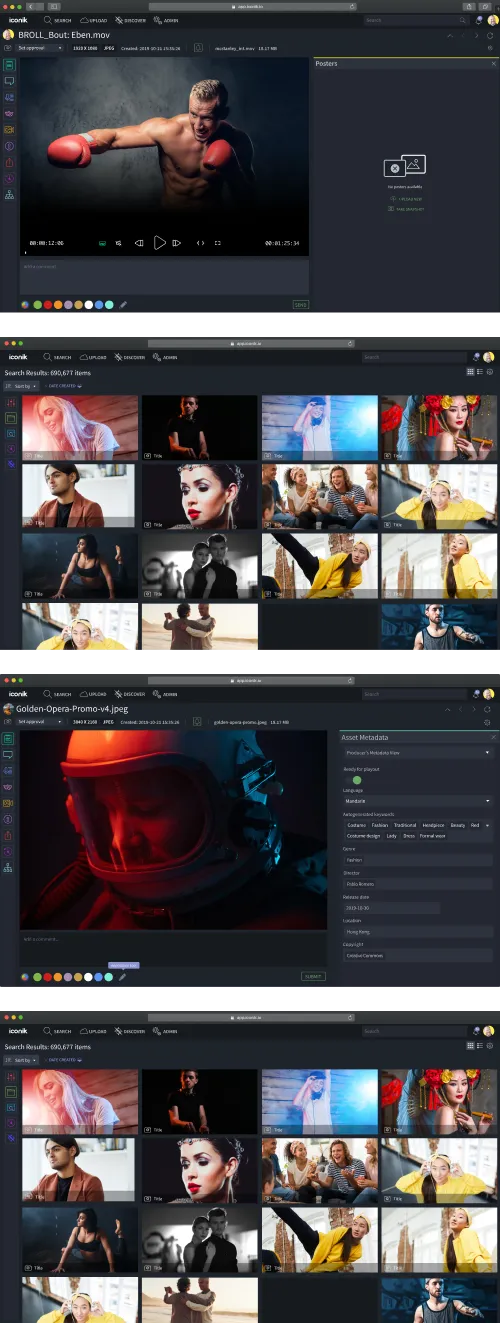How should you deal with the vast quantity of digital media your organization is producing? As you create ever more videos, images, and audio, your traditional file storage will soon start to strain under the pressure.
If you’ve reached the limits of standard file browsers, you have, broadly speaking, two options: digital asset management (DAM) and media asset management (MAM).
Both these technologies help store large digital files and share many elements in common. Indeed, MAM is technically a subcategory of DAM. But while they share some similarities, they are actually very different technologies - both in terms of functionality and how organizations use them.
In this article, you will learn:
- What a DAM is
- What a MAM is
- Similarities between DAM and MAM
- 5 key differences between MAM and DAM
- The growing relevance of MAM outside ‘traditional’ media businesses
What is a DAM?
Traditionally, a digital asset management (DAM) system could be seen as a brand asset management or library asset management system. The content managed often revolves around sales and marketing and can include assets such as logos, marketing materials (brochures, banners, etc.), or product photographs. It is the source of truth for approved assets.
What is a MAM?
A Media Asset Management (MAM) system is focused on rich media assets (e.g., video and audio). Unlike a DAM, which is more general in its approach to digital asset management, MAMs tend to be specifically tailored for very large video files and have features to support production workflows. It is the source of truth for all assets, approved or unapproved, raw or finished.
Key similarities between DAM & MAM
The common nature of these solutions means that there will be overlapping features you can expect to see in both.
Features found in both DAM & MAM
- Asset search capabilities
- Metadata tagging
- Secure storage and access
- Digital rights management
- Version control
- Access control
- User management
So far, DAM and MAM sound quite similar. Now, let's consider the key differences since these will quickly become apparent once you begin to apply these solutions to your workflows.
5 key differences between DAM & MAM
1. User accessibility
If you can't access your media, it might as well not exist at all. When it comes to the accessibility of your media, DAM and MAM will do this differently. DAM is designed for large-scale access and delivery for entire organizations, the press, and even the public. It allows users to quickly and easily search for content, view files, and download assets for their own use.
On the other hand, MAM is best suited for limited access for internal teams and only select collaborators, often requiring authentication before allowing users to access and manage specific collections of files. In this regard, DAMs are more user-friendly with more accessibility, while MAMs are more secure, allowing only those with the proper credentials to gain access to the content.
Takeaway: DAM is your general bucket for approved files, and MAM is focused on managing content for select users through the production process.
2. Hot and cold storage
The way DAM and MAM handle storage can be fundamentally different. Data storage can be classified into two groups: hot and cold. Hot storage is any type of data storage that is immediately accessible, while cold storage is for long-term archiving of large amounts of data. Hot storage, as the name suggests, allows for instant retrieval of data and provides more performance and speed. Cold storage, on the other hand, is ideal for storing static data that is rarely accessed. Since these files are not accessed frequently, they can be stored in less expensive cloud storage or media such as tape or optical storage.
A MAM system takes advantage of both hot and cold storage to securely store and archive media files for long-term preservation. As media progresses through its lifecycle, a MAM can facilitate moving it from hot to cold storage. However, if raw or archived assets need to be moved from a DAM, it’s possible that you’ll find that there’s no concept of where to put them; everything goes in the same place: hot storage—and it can be pricey. In fact, the DAM business model is centered on selling storage. Whether you use it or not, the cost remains.
Takeaway: DAM focuses on hot storage and instant access; MAM offers both hot storage and cold storage.
3. Large file support
Video files are substantially larger than other types of media files, which comes with its own set of unique challenges when it comes to storage and distribution. If you’re dealing with video content, you need to have solutions that will help you store, edit, and share video as smoothly as possible.
A DAM system is specifically designed to store, organize, and distribute digital assets—files of any kind. When it comes to large media files like video or video project files, DAM, by design, will be limited in how fast it can process and preview large files.
A MAM, by contrast, is designed to manage millions of files, with sizes in multiple terabytes. The ability to handle this amount of data is crucial when managing libraries of rich media and enabling on-premise or cloud-based file workflows.
4. Video format support
MAM systems are designed specifically for video. This focus allows MAM to provide tools for video production workflows, such as transcoding, proxy files, multiple asset formats, fast previews, metadata management, and rights management.
DAMs can handle the most popular video formats like h.264, but they have a reputation for limited video codec support and not being able to handle camera native media like Red, XDCam, or ProRes. If you are managing and creating video, MAM systems offer a level of functionality that other asset management solutions just can't match.
Takeaway: If you’re producing and editing a range of video types, choose a MAM.
5. Production management
MAMs are better for production because they are designed to manage assets through every stage of the media lifecycle, from ingestion and production to post-production and distribution. This also means that MAMs are better equipped to facilitate video creation by integrating with media production software.
DAMs are best for finished assets that are approved for distribution because that is what they were designed to do. However, DAMs will struggle with raw assets like b-roll footage, audio, video, or animation project files and post-production workflows. When creative teams are expected to manage raw assets and finished assets in one DAM, it can be frustrating because DAMs are not made for this.
Takeaway: Use MAM for production processes and DAM for finalized and approved assets.
Summing it up: MAM for production workflows, DAM for branding/marketing
In practice, production teams in the film, broadcast, or video industry would use MAM to manage, store, and work with video files for video post-production workflows. But if your branding and marketing require management of still images, graphics, or textual content, then DAM software would be a good choice.
Suggested: Five key features to look for in a media asset management system
The growing relevance of MAM outside traditional media businesses
MAM technology has developed significantly in recent years, and use cases have evolved. Old blanket statements like "MAM is just for large video files" or "MAM is just for media and entertainment companies" no longer hold true.
While a MAM is still the go-to solution for film and TV production, the rising demand for video is touching every industry. Major changes in the way companies engage their market with media are fueling the shift to video-centric solutions. Recent analysis shows that in 2025, some 89% of businesses use video as a marketing tool, up from 61% in 2016. With more types of companies producing video content, there is a far greater need for MAM.
As new content fills the archives, organizations from every sector are looking for systems that allow them to create, organize, store, and share media files. This has made MAM systems a crucial tool for teams that require quick access and efficient collaboration with media. As a result, many DAM users are choosing to switch to a MAM.
At iconik, we’re on the leading edge of media management technology. We’ve defied the traditional boundaries of asset management categories (MAM, DAM, PAM) in our commitment to solving the problem of finding and using media. iconik is an extremely affordable, flexible solution built to accommodate the rising demand for media management in businesses of every size. The platform is now used by an enormous range of organizations, from ‘typical’ media firms (like VICE Media or CineSys) to a huge range of businesses in diverse sectors (think higher education, the charity sector, or agribusinesses) that are now producing and publishing video at scale. iconik serves an ever-growing range of firms as a media management solution, a collaboration hub, a one-stop shop for post-production, and a platform to build and tie together complex media systems.
Read to see how it could work for your business. Request a demo today.
Give iconik a try
Schedule a personalized iconik demo with one of our experts and start your free trial today.


Steve Ferris is content creator and marketer from Indiana, USA who is based in Stockholm Sweden with his family. Since 2019, he's been with iconik using his 20 years experience in storytelling to share the stories around iconik and media professionals.
Take the MAM Diagnostic Quiz
Need better media management?
Get tailored results to see where your biggest wins with iconik would be.
-Mar-05-2024-07-18-15-7861-PM-Mar-05-2024-09-43-26-2324-PM.png)